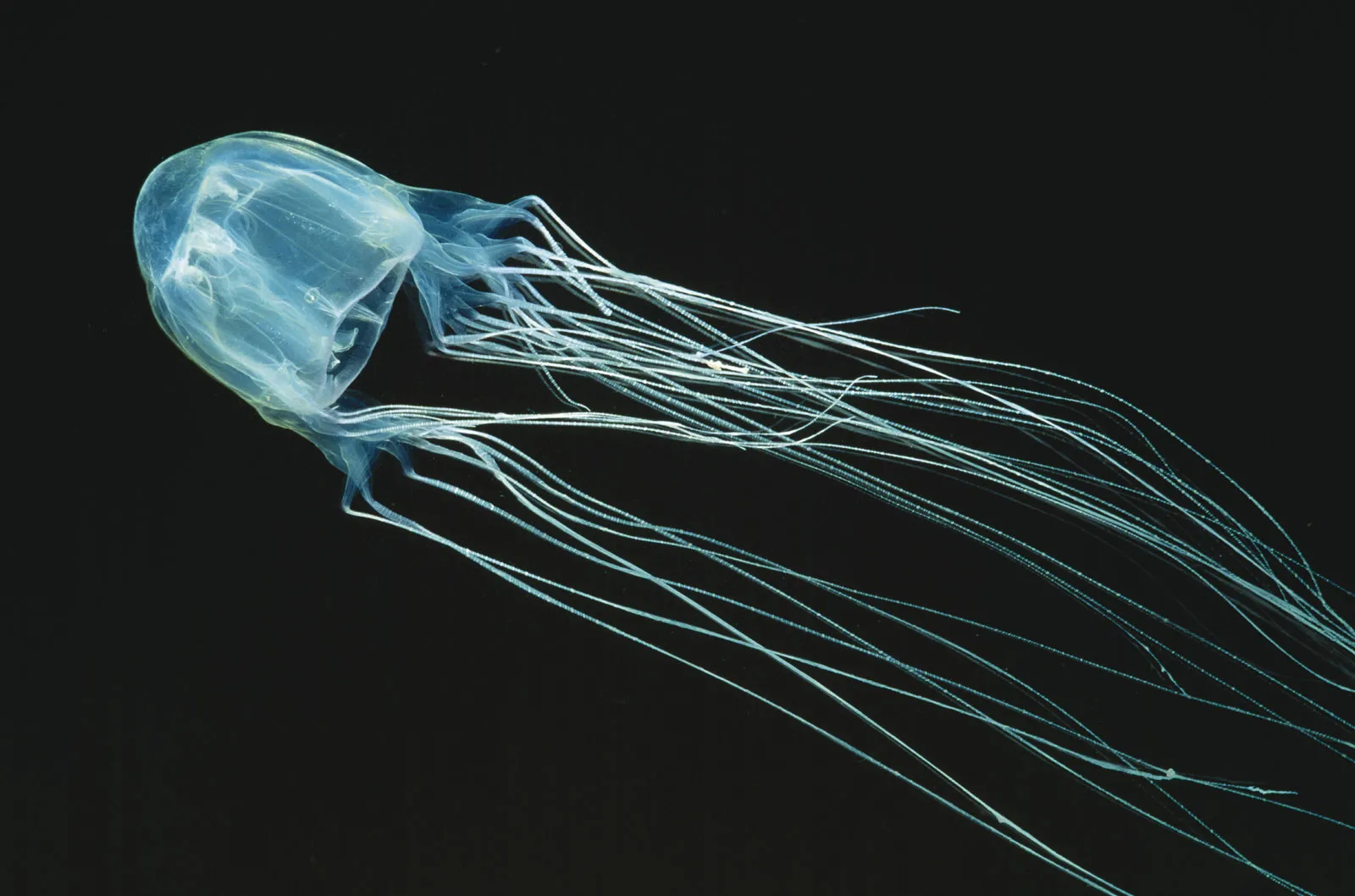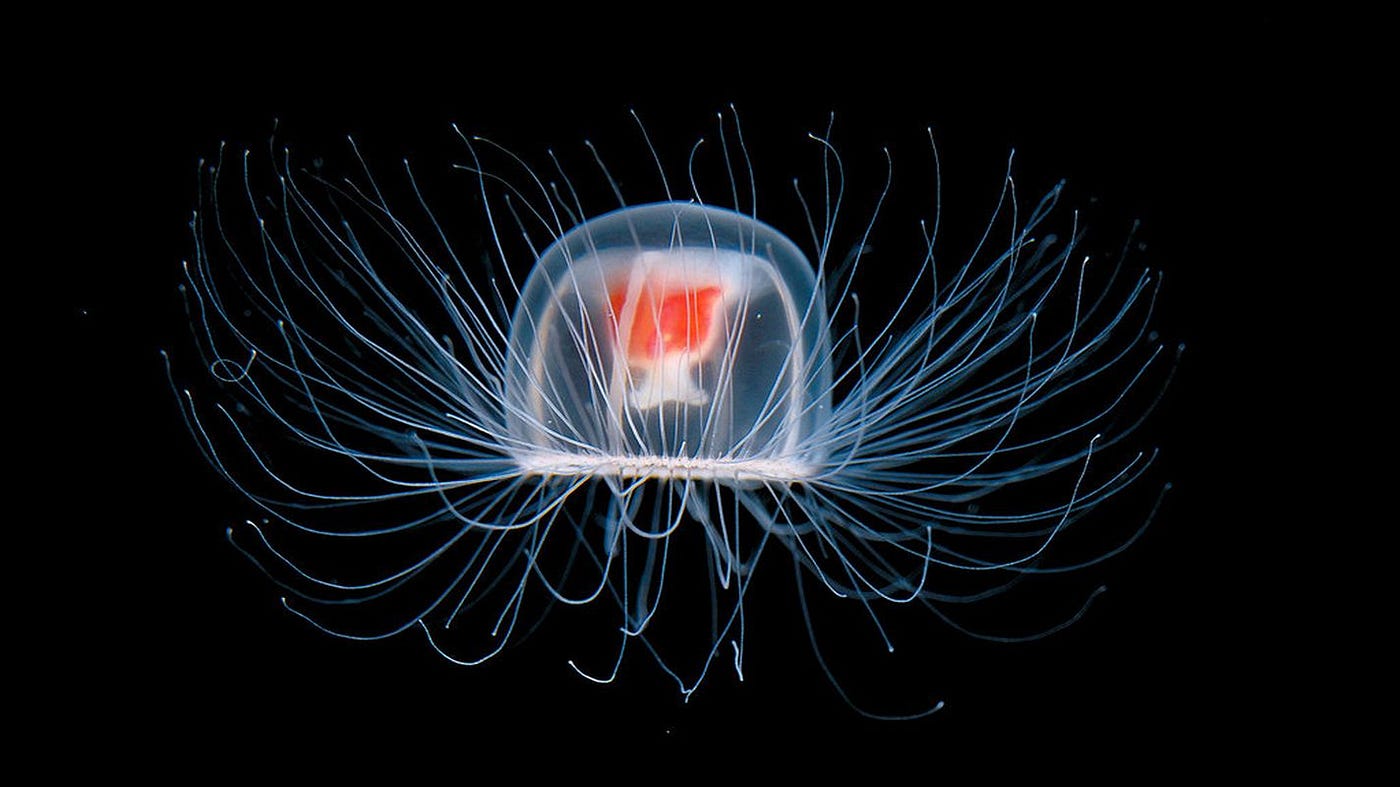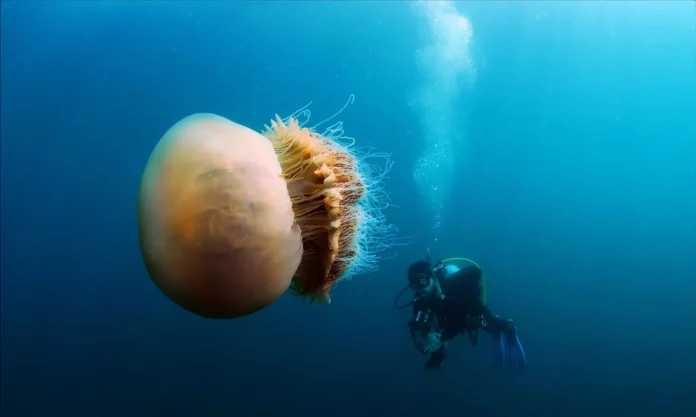The largest and most dangerous jellyfish in the world – the Cyanea (Cyanea capillata, Cyanea arctica)
The Arctic (or Lion’s Mane) jellyfish inhabits the Pacific and Atlantic Oceans, primarily at great depths, but occasionally near the coast. While the Cyanea jellyfish can be dangerous to humans, its venom only causes rash and allergies, not death.
Size of the Cyanea: the diameter of its bell can reach up to 2 meters, while the tentacles of this deep-sea monster can stretch up to 25-30 meters.
The most dangerous jellyfish in the world
The Box jellyfish (Chironex fleckeri), seemingly harmless at first glance, possesses venom so potent it can kill 60-70 people in just 4-5 minutes. The jellyfish inflicts severe burns, causing intense pain and burning. Even when aware of the danger, it’s hard to look away from the jellyfish. Thanks to the smooth muscle contractions, the jellyfish moves in the water like a young ballerina. Smooth and graceful, it draws attention, yet carries deadly danger. It’s difficult to believe, but the toxin in its body retains its deadly properties for nearly a month after the jellyfish’s death.

No snake, spider, or insect can kill a person as quickly as the Box jellyfish. Therefore, it holds the first place as the most lethal creature on the planet.
There is an antidote for the Box jellyfish, but you’d have to carry it with you as you wouldn’t have time to reach it. Once stung by the jellyfish, within 3-4 minutes, severe pain can cause a heart attack, and the victim simply drowns.
Box jellyfish of this type mainly inhabit the waters of Australia during the summer. A small number has also been found in coastal waters of Southeast Asia.
The size of the Box jellyfish is not impressive: it barely reaches 20-45 cm in bell diameter, while its tentacles can extend up to 2-3 meters in length during hunting. This jellyfish is difficult to spot as it is nearly transparent.
Interesting facts about jellyfish
Externally, all jellyfish look similar. Their bodies resemble a dome or bell. Despite being made up of 97% water, the structure of these unusual fauna representatives is far from simple. Even the shades of their shells come in dozens of different variations! There are pale pink inconspicuous babies, as well as brightly golden, blue, and even red giants.
In addition to their bodies, jellyfish have venomous tentacles, which they use for hunting. The amount of venom released depends on the prey the hunter prefers. It is almost impossible to determine the maximum size of the tentacles. Throughout their life, jellyfish continue to grow. Thus, some individuals, reaching 40 meters in length, have been found in the northwestern part of the Atlantic Ocean. They belong to a species called the “Lion’s Mane.”
Wrapping the prey with its tentacles, the jellyfish immobilizes or kills it with a dose of venom, then sends it into the orifice for digestion. But the lethal toxin can also be used for defense.
Deadly underwater lights
Scientists have discovered many species of jellyfish that have luminescent properties. In other words, they are capable of emitting some amount of light while in complete darkness. Individuals living closer to the water surface often tint the surrounding space blue or pale green.
Deep-sea dwellers, on the other hand, more often possess red or purple luminescence. And such a property of jellyfish cannot be called a banal decoration. It is another ingenious hunting tactic.
Given that most jellyfish feed on tiny shrimp or plankton, they have to expend a considerable amount of effort to find food. This task becomes especially challenging in complete darkness. However, the process is significantly simplified by the attractive light emanating from the hunter. Like moths to a flame, alluring creatures gather around it. The jellyfish then simply chooses the most appetizing dish, much like in an expensive restaurant.
For humans, bright gatherings on the ocean’s surface appear simply as an evening show. Photos of the deep green ocean surface, beneath which seems to be a noisy disco, regularly appear on the internet. No one even realizes that at that moment, a real hunt is taking place there, albeit endlessly beautiful for the casual observer.
Jellyfish can be eaten
Not only biologists and deep-sea researchers are interested in jellyfish. They find application in other spheres of human life as well. For example, it has been proven that observing the smooth, graceful “flight” of jellyfish relieves stress and helps people relax. That’s why in Japan, aquariums increasingly feature them, rather than ordinary darting fish.
Moreover, in several countries, jellyfish are consumed as food. They are even considered delicacies there! However, only a few species are edible. After capture, their tentacles, which contain venom, are removed, while the body undergoes further processing. The most popular forms are dried or canned jellyfish.
Although they turn into unattractive, thin sheets after drying, the taste qualities, if believed by gourmets, remain simply magnificent. In restaurants in Thailand or Japan, it’s easy to find salads with jellyfish, noodles, or even ice cream.
For locals, these dishes are not shocking. Jellyfish harvesting for consumption occurs on an industrial scale. However, for foreign tourists, such an unusual ingredient will undoubtedly become a whole event.
As for desserts, jellyfish are rarely used in the form of pieces or, even more so, whole. Extracts and powders have already been developed, which only impart the aroma of sea breeze or ocean depths to sweet dishes without burdening them with a viscous texture. Although this may sound somewhat extravagant to lovers of ordinary cakes and pastries, such culinary masterpieces have found their admirers.
Immortal jellyfish
It was among jellyfish that the first truly immortal creature on the planet was found. Its scientific name is “Turritopsis Nutricula.” These creatures live out their life cycle from beginning to end, but after biological death, they do not begin to decompose like other organisms.

They simply sink to the ocean floor, where the process of regeneration begins. After some time, Turritopsis is ready to roam the ocean depths again and consume its smaller inhabitants.
Other creatures with a similar regeneration mechanism have not yet been found. And this is just one of the factors that make jellyfish unique and irreplaceable. According to research, they lived on Earth long before the dinosaurs appeared, and to this day, they have almost remained in the same form.
For humans, it remains only to admire the creation of evolution and strive with all their might to keep the World Ocean suitable for the life of these somewhat mythical creatures, still so little studied by us.
